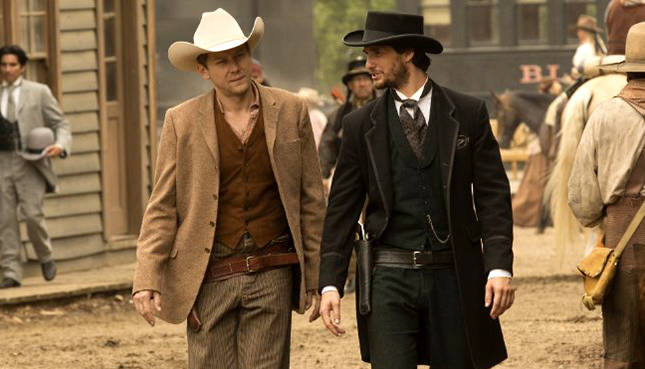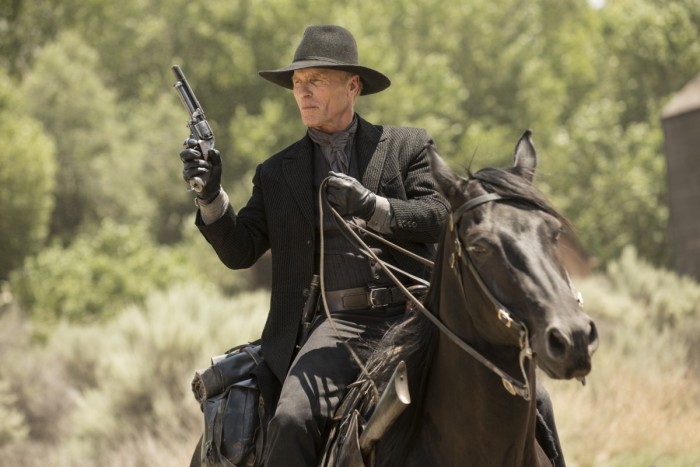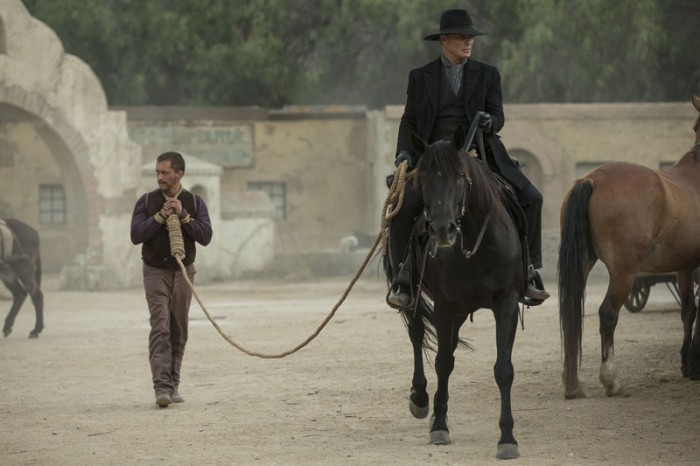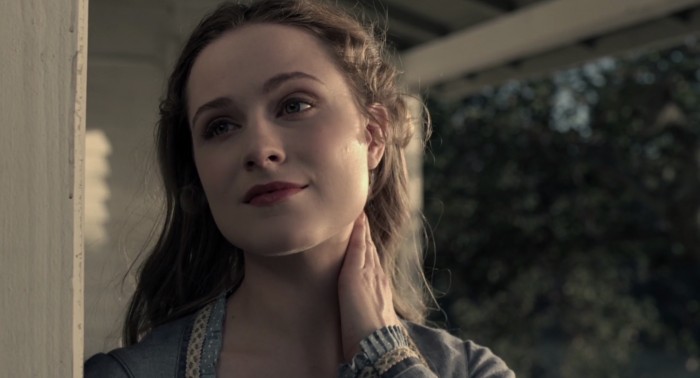How This Week's Episode Might (Or Might Not) Debunk The Craziest 'Westworld' Theory
Like the robots at the center of the plot, Westworld constantly asks the viewer to examine the nature of the show's reality. Usually, these questions stem from plot threads that demand further exploration, like what actually happened to Arnold, the mysterious co-founder of Westworld whose existence has been scrubbed from the park's official history. Other questions deal with the logistics of the park itself, specifically where this massive place could possibly be located (especially since it's difficult to communicate with the outside world and the staff is required to live on site and rotate out every few months).
Those discussions have emerged from dialogue and plot threads on the show, with the series inviting analysis because of something a character says or, more often, something they do not say. One of the strangest conversations surrounding Westworld feels like a shot in the dark, albeit a fascinating shot in the dark that has just enough evidence to make sense. And the latest episode, "The Stray," either proves it to be true or...proves it to be untrue.
Naturally, spoilers for aired episodes and speculation for future episodes follow.
The Players
Although the focus of Westworld so far has been on the robotic "hosts" who populate the titular futuristic theme park and the men and women who keep things running behind the scenes, we have met a few noteworthy guests. First, there's the mysterious "Man in Black" (Ed Harris), a veteran parkgoer who has been visiting Westworld for 30 years. Although his true identity remains unknown (a case where, once again, we are invited to speculate via omission), we know that he's known to the Westworld staff. When he went on a bloody rampage in "Chestnut," head of park security Ashley Stubbs made it clear that this particular guest was allowed to do whatever he wanted with no restrictions. He's like a Disneyland season pass holder who comes to the park so often that he's allowed to occasionally bend the rules.
We have also met William (Jimmi Simpson), a first-time visitor to the park who has been dragged along by his fiancee's brother, Logan (Ben Barnes). William is literally gun-shy about his time in the park, showing no interest in the kind of seedy business that appeals to future brother-in-law. In fact, his decision to follow a "white hat" storyline involving a hunt for a local criminal annoys Logan to no end, who only wants to hang around the central hub to drink and screw.
The only thing that connects the Man in Black and William (beyond them both being flesh and blood) is that they've connected with the rancher's daughter, Dolores (Evan Rachel Wood). William shares a fleeting moment with her when he displays an act of kindness by picking up the canned good she drops in the street. The Man in Black also participates in the same act of kindness, but it's more out of his own amusement, allowing him to quietly gloat about the number of times he has murdered and assaulted her over the years.
And this connection is the seed of the theory we're here to examine.
The Theory
What if the Man in Black and William are the same person, thirty years apart? If true, that means we've been watching two storylines unfold across two timelines, with William's first trip to Westworld taking place decades in the past while the action revolving around the Man in Black takes place in the current timeline.
From a logistical point of view, it can make sense. After all, the hosts do not age, so it's easy for Jimmi Simpson and Ed Harris to both encounter Evan Rachel Wood at different points with nothing changed. Even more importantly, none of the major park ops characters (like Jeffrey Wright's Bernard or Anthony Hopkins' Robert Ford) have shared the screen with Simpson or Barnes. However, Luke Hemsworth's Stubbs, who has shared scenes with those characters, has openly acknowledged the Man in Black. By simply omitting an obvious connection, this theory gains weight. Other details, like how the interior of the train that transports guests to the park looks different each time we've seen it, only add additional fuel to the fire.
And perhaps most importantly, there's the way both William and the Man in Black are there to pick up that stray can for Dolores. For William, it's an accident of timing. For the Man in Black, it's planned because he knows this particular narrative like the back of his hand. Each interaction echoes the other and this could be Harris' older William essentially mocking his younger self and the way he used to interact with the park's inhabitants.
Plus, executive producer Jonathan Nolan (who runs the show alongside Lisa Joy) has a history of playing with narrative and timeline in surprising ways, having written the story that was the basis for Christopher Nolan's Memento. This kind of a crazy twist is in his wheelhouse.
Some Additional Speculation
Let's say this theory is true (and I'm honestly not convinced that it is). Let's say that William and the Man in Black are one and the same. If so, how does the kind man of past years transform into the cruel, loathsome killer and rapist of later years?
In my review of the first episode, I pondered if Westworld was actually something of a secret sequel to the original 1973 movie. After all, park staff referenced a previous park failure that took place 30 years earlier, even though things had been running smoothly since then.
In the original film, a catastrophic glitch causes the robots to run amok and begin murdering guests, forcing the lead character to fight for his survival after his friend is killed in front of him. What if (and this is just me speculating into the wind) we're watching a simultaneous remake and sequel to the original film? What if the Jimmi Simpson timeline is the movie's plot, where two friends find their lives threatened during a robot uprising? What if William watches Logan get killed by a host and barely survives himself? What if the park keeps the incident quiet and rewards William with a lifetime pass to the park and the free reign to do whatever the hell he wants? And what if the robot who killed his friend is Dolores, the oldest robot in the park, so he's spent the past decades going out of his way to torment her and make her existence a living hell?
That is a whole bunch of "what ifs" without much evidence at all, but if William and the Man in Black are the same person and with full knowledge of the story Michael Crichton told over 40 years ago, the pieces do start to align.
The Kicker
But here's the thing: "The Stray" seemingly nipped this theory in the bud during its final scenes. Dolores once again endures the scripted attack on her family and she is once again dragged into the barn by an assailant. However, a mysterious voice (the "bicameral mind") allows her to override her programming and kill her attacker with a pistol. But before she pulls the trigger, she sees flashes of the Man in Black, memories of him assaulting her. Once she escapes into the woods, she stumbles across William and Logan. This means she was remembering the Man in Black attacking her moments before she runs into William again, meaning that both guests exist in the same timeline. Surely this takes this concept that we've spent far too much speculating over and rips it apart. Right?
Maybe? Because Sean Fitzgerald over at Thrillist has written an excellent article explaining how this revelation may be clever misdirection that uses invisible cuts through time to lay further groundwork for the two timelines:
Dolores experiences déjà vu when she returns to the ranch. Viewers witness two versions of the same scenario through her eyes: bandits murdering her family and someone dragging her into a barn. In one instance, she sees her new dad and Westworld's version of Yosemite Sam. In the other: the old Peter Abernathy and The Man in Black. She experiences the present while having flashbacks to the past, and projects her memories for the audience to see – the same phenomenon that happened in her pistol discovery scene. Someone's voice — Bernard? Dr. Ford's old accomplice "Arnold"? A newly awakened subconscious? – tells her to shoot, officially defying her programming.
The episode ends with Dolores retreating from the farm and stumbling into William's arms. It's hard to tell exactly what's happening, and more importantly, when it's happening. But remember: Dolores sees her new dad first, then she remembers her old dad; the mustachioed bandit locks Dolores in the barn first, then she remembers the Man in Black. The pattern is present, past; present, past. If the end of the ranch scene follows this same pattern, Dolores receives a bullet to the stomach first, then she remembers escaping to William unscathed. In other words, the last scene of this episode is a memory of the past.
In other words, the latest episode of Westworld either completely disproves the show's craziest theory or it completely proves it.
Well, I guess I'll see you guys next week.




